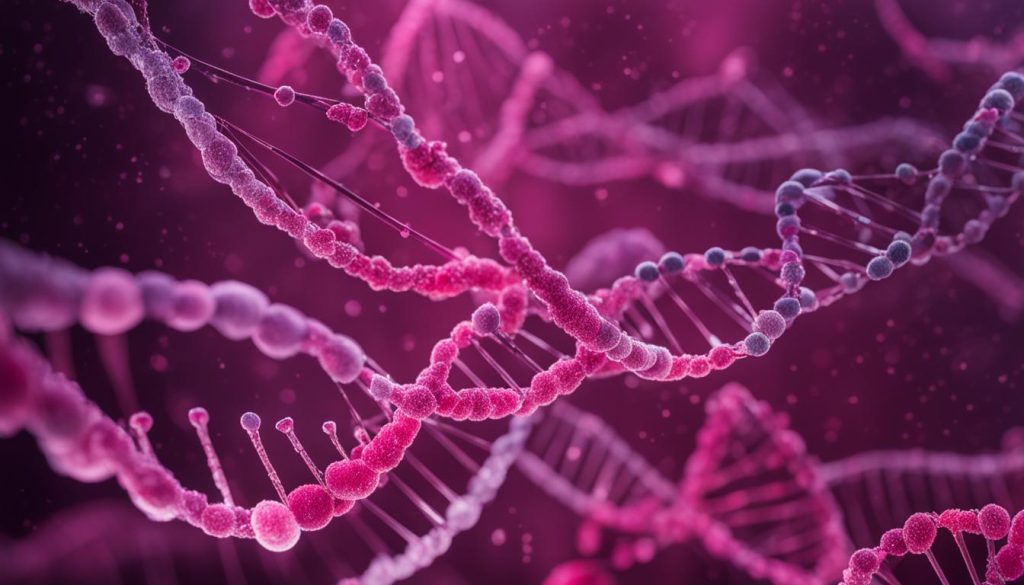When it comes to breast cancer, there are various risk factors that can increase a person’s chances of developing the disease. Factors such as age, genetic mutations, and reproductive history can all play a role in determining breast cancer risk. Additionally, there are modifiable risk factors that individuals can take proactive steps to address, such as physical inactivity and alcohol consumption.
By understanding these breast cancer risk factors and conducting a thorough breast cancer risk assessment, individuals can make informed decisions about their health and take the necessary steps to protect themselves. Whether it involves lifestyle changes, regular screenings, or genetic testing, being knowledgeable about these factors is crucial in minimizing the risk of breast cancer.
Factors that Increase Breast Cancer Risk
When it comes to breast cancer risk, there are both non-modifiable and modifiable factors that can play a role. Non-modifiable risk factors are those that cannot be changed or controlled, while modifiable risk factors are those that individuals can take steps to change and minimize their risk. By understanding these risk factors, individuals can make informed choices to protect their health.
Non-modifiable Risk Factors for Breast Cancer
Age is a significant non-modifiable risk factor for breast cancer. As individuals get older, their risk increases. Genetic mutations, such as BRCA1 and BRCA2, also play a role in breast cancer risk. These mutations can be inherited and significantly raise the risk of developing breast and ovarian cancers.
Other non-modifiable risk factors include reproductive history, having dense breasts, personal history of breast cancer or certain non-cancerous breast diseases, family history of breast or ovarian cancer, previous radiation therapy, and exposure to the drug diethylstilbestrol (DES). These factors cannot be changed, but being aware of them can help individuals understand their risk and take appropriate actions.
Modifiable Risk Factors for Breast Cancer
There are several modifiable risk factors for breast cancer that individuals can actively address. Not being physically active, being overweight or obese after menopause, taking certain hormones, and having a history of delayed pregnancy, not breastfeeding, or never having a full-term pregnancy can increase the risk of breast cancer.
Additionally, research suggests that alcohol consumption may increase the risk of breast cancer. By making lifestyle changes, such as engaging in regular physical activity, maintaining a healthy weight, limiting alcohol intake, and discussing hormone therapy with a healthcare provider, individuals can lower their risk and protect their health.
It is important to note that while certain risk factors cannot be changed, individuals have the power to make positive choices that reduce their overall risk of developing breast cancer. By understanding the factors that increase breast cancer risk and taking proactive measures, individuals can take control of their health and well-being.
Genetic Risk Factors for Breast Cancer
Genetic mutations play a significant role in determining an individual’s risk of developing breast cancer. Certain inherited gene mutations, such as BRCA1, BRCA2, and PALB2, have been identified as high-risk factors for breast and ovarian cancers. These mutations can be passed down from parent to child and substantially increase the likelihood of developing these diseases. However, it is important to note that not everyone with these mutations will develop cancer, and not all breast cancers are caused by genetic mutations.
In addition to the well-known BRCA genes, there are other gene mutations and hereditary syndromes that are also associated with an increased risk of breast cancer. These include Lynch syndrome, Cowden syndrome, Li-Fraumeni syndrome, Peutz-Jeghers syndrome, and Ataxia telangiectasia. Although these mutations are less common, individuals with a family history of these syndromes should consider genetic testing to determine their risk.
Genetic testing is available to identify these mutations and provide individuals with valuable information about their cancer risk. It can help individuals make informed decisions about their health, including preventive measures and screening schedules. By knowing their genetic risk factors, individuals can work with their healthcare providers to develop personalized strategies to reduce their risk of developing breast cancer.
Genetic Testing and Decision Making
The decision to undergo genetic testing is a personal one and should be made in consultation with a healthcare professional. Genetic counseling is often recommended to discuss the benefits, limitations, and implications of genetic testing. A genetic counselor can explain the testing process, interpret the results, and help individuals understand their risk and the available options for prevention and early detection.
It is important to remember that genetic testing is not recommended for everyone. The presence of a genetic mutation does not mean that breast cancer is inevitable, and the absence of a mutation does not guarantee that an individual will not develop the disease. Genetic testing is most appropriate for individuals who have a strong family history of breast or ovarian cancer, particularly if multiple family members have been affected at a young age.
Ultimately, genetic testing provides individuals with valuable information about their risk of developing breast cancer. Armed with this knowledge, individuals can take proactive steps to protect their health, such as engaging in regular screening, adopting a healthy lifestyle, and considering preventive measures if necessary. By understanding their genetic risk factors, individuals can make informed decisions that empower them to take control of their breast health.


Lifestyle Factors and Breast Cancer Risk
When it comes to breast cancer risk, certain lifestyle factors can play a significant role. By understanding and addressing these factors, individuals can take proactive steps to reduce their risk and protect their health. Let’s take a closer look at some lifestyle choices that may increase the risk of breast cancer.
Physical Inactivity and Weight Management
Leading a sedentary lifestyle and being overweight or obese after menopause have been linked to an increased risk of breast cancer. Engaging in regular physical activity, such as brisk walking, jogging, or cycling, can help maintain a healthy weight and reduce the risk of developing breast cancer.
Hormone Use and Reproductive History
Some hormone-related factors can also affect breast cancer risk. Taking hormone replacement therapy (HRT) or oral contraceptives that contain estrogen and progestin may slightly increase the risk. Additionally, a woman’s reproductive history, including delayed pregnancy, not breastfeeding, and never having a full-term pregnancy, can also contribute to a higher risk of breast cancer.
Alcohol Consumption
Another lifestyle factor that has been associated with an increased risk of breast cancer is alcohol consumption. Even moderate drinking can influence the risk, so it’s important to be mindful of alcohol intake and consider reducing or avoiding it altogether.
To minimize the risk of breast cancer, it is essential to make positive lifestyle choices. Engaging in regular physical activity, maintaining a healthy weight, discussing hormone use with your healthcare provider, and moderating alcohol consumption are all steps that can help reduce your risk. By taking control of these lifestyle factors, you can take proactive measures to protect your health and well-being.


Screening and Prevention
Regular screening and early detection are essential in the prevention and detection of breast cancer. It is important for individuals to be aware of changes in their breasts and to discuss regular breast examinations and mammograms with their healthcare provider. Mammograms, MRIs, and ultrasounds are imaging tests that can detect abnormalities in the breast tissue. These tests play a crucial role in identifying potential signs of breast cancer at an early stage, when treatment options are often more effective.
In addition to regular screenings, there are steps individuals can take to lower their risk of breast cancer. Maintaining a healthy weight through a balanced diet and regular physical activity is one important factor. Limiting alcohol consumption and breastfeeding, if possible, are also associated with a reduced risk of breast cancer. It is important to note that the risks and benefits of hormone therapy should be discussed with a healthcare provider, as this can also impact the risk of developing breast cancer.
In some cases, individuals may be at a higher risk of breast cancer due to family history or genetic mutations. Genetic testing can help identify individuals who are at increased risk. For those at high risk, preventive medications or even surgery may be considered to further reduce the risk of developing breast cancer. It is important to work closely with a healthcare provider to determine the best course of action based on individual risk factors and personal health history.
Conclusion
Understanding breast cancer risk factors is essential for taking proactive steps to protect my health. While certain risk factors, such as age and genetic mutations, cannot be changed, I can make lifestyle choices that reduce my risk. Maintaining a healthy weight, staying physically active, and limiting alcohol consumption are important ways to lower my risk of developing breast cancer.
Regular screening and early detection are also crucial in preventing and detecting breast cancer. Being aware of changes in my breasts and discussing regular examinations and mammograms with my doctor can help identify any abnormalities early on. Additionally, staying informed about the risks and benefits of hormone therapy and discussing them with my healthcare provider can further mitigate my risk.
By empowering myself with knowledge and taking proactive measures, I can significantly reduce my risk of developing breast cancer. It’s important to remember that breast cancer risk factors vary for each individual, and it’s crucial to consult with my healthcare provider to assess my specific risk and create a personalized prevention plan. With regular screenings, awareness of changes in my breasts, and making positive lifestyle choices, I can protect my health and well-being.
FAQ
What are the risk factors for breast cancer?
Risk factors for breast cancer include being a woman, getting older, genetic mutations (such as BRCA1 and BRCA2), reproductive history, having dense breasts, personal history of breast cancer or certain non-cancerous breast diseases, family history of breast or ovarian cancer, previous radiation therapy, and exposure to DES.
Can I change my risk factors for breast cancer?
Some risk factors for breast cancer cannot be changed, such as age, genetic mutations, and reproductive history. However, there are modifiable risk factors that individuals can take steps to change, such as physical inactivity, being overweight or obese after menopause, taking certain hormones, reproductive history, and alcohol consumption.
How do genetic mutations contribute to breast cancer risk?
Certain inherited genetic mutations, such as BRCA1, BRCA2, and PALB2, are associated with an increased risk of breast cancer. Other gene mutations and hereditary syndromes are also linked to increased breast cancer risk. Genetic testing is available to identify these mutations and help individuals make informed decisions about their health.
What lifestyle factors can increase breast cancer risk?
Lifestyle factors that can increase breast cancer risk include not being physically active, being overweight or obese after menopause, taking certain hormones, reproductive history, and alcohol consumption. Smoking, exposure to chemicals that can cause cancer, and night shift work may also increase the risk.
How can I reduce my risk of breast cancer?
To reduce the risk of breast cancer, individuals can maintain a healthy weight, engage in regular physical activity, limit alcohol intake, breastfeeding if possible, and discuss the risks and benefits of hormone therapy with their healthcare provider. Regular screening and early detection are also important for prevention.
